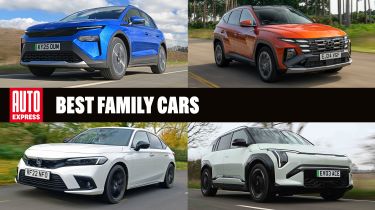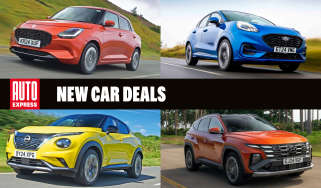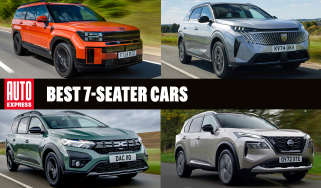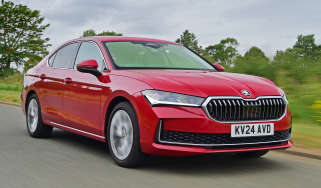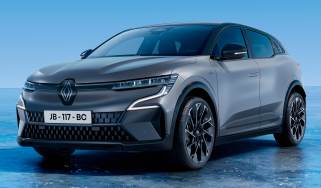Best family cars to buy 2025
Family cars come in a variety of shapes, from hatchback to SUV. But which is best for you?
The best family cars boast a diverse skill set, making them able to cope in the wide variety of different situations that life with children tends to throw up (hopefully not in the literal sense). These cars should be practical, reliable, safe, and solidly built to take all that life can throw at them.
But those are essentials; we also want a family car to look good, have a dash of style, and drive with more than a hint of agility. They should also be comfortable and come with lots of advanced tech to make life on the road with a family easier to manage. Oh, and we also want a selection of different powertrains so we can select what works best for us - petrol, diesel, hybrid, plug-in hybrid or electric.
A tall order? Perhaps, but our road test experts have thoroughly tested every family car on sale in the UK and gathered this list of the top 10 best family cars that deliver across the board.
Compare the 10 best family cars
You can compare our full review ratings for the best family cars by using the table below, along with the starting price, maximum WLTP combined efficiency and boot space. Keep scrolling for more details on every car…
| Rank | Car | Overall rating | Prices from | Max. WLTP efficiency/battery range | Boot space |
| 1 | Skoda Octavia | 4.5 | £27,390 | 66.2mpg | 600 litres |
| 2 | Skoda Elroq | 5 | £31,500 | 355 miles | 470 litres |
| 3 | Dacia Jogger | 4.5 | £18,970 | 58.9mpg | 212 litres |
| 4 | Skoda Superb | 4.5 | £35,695 | 784.3mpg | 645 litres |
| 5 | Hyundai Tucson | 4.5 | £32,400 | 201.8mpg | 620 litres |
| 6 | Kia EV3 | 4.5 | £33,005 | 4.2mi/kWh | 460 litres |
| 7 | Honda Civic | 4 | £35,780 | 56.5mpg | 410 litres |
| 8 | Hyundai Kona | 4.5 | £26,465 | 60.1mpg/4.2 Mi/kWh | 466 litres |
| 9 | BMW i4 | 4.5 | £51,280 | 373 miles | 470 litres |
| 10 | Citroen C4 | 4 | £22,585 | 62.1mpg | 380 litres |
1. Skoda Octavia
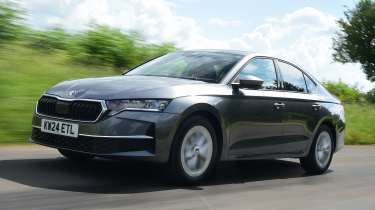
- Prices from £27,390
- Best all-round family car on sale
Pros |
Cons |
| Huge boot | Not as cheap as its predecessor |
| Comfortable ride | Some rivals are more fun to drive |
| Smart interior design | Rear headroom is a little compromised |
‘All-rounder’ is a term coined for the Skoda Octavia. It simply does almost everything very well, and a few things brilliantly.
As you’d expect, the Skoda Octavia Estate is the most practical option with a stonking 640 litres of boot space, but the hatchback really isn’t far behind with 600 litres. In short, both variants can take on pushchairs, shopping and just about anything else you can throw at them. Passengers have a huge amount of space to enjoy, too, and even our tallest road testers had plenty of room to stretch their legs while sitting in the back seats.
The Octavia is primarily a sensible car rather than a fun one, although there is the option of the sportier vRS version if you desire a bit more power. The standard cars are respectably comfortable and refined, though, and munching up motorway miles is a complete doddle.
The plug-in hybrid Octavia iV is currently unavailable to buy brand new, so those who want the best fuel economy will be best served by the diesel models, which can easily surpass 60mpg. Opt for a petrol mild-hybrid, though, and an average figure of over 50mpg won't be much of a struggle, either. The latter is also a little bit cheaper to buy.
This combination of practicality, quality and overall ease of use made the Skoda Octavia an obvious choice for Family Car of the Year award, and its keen starting price only sweetens an already excellent deal.
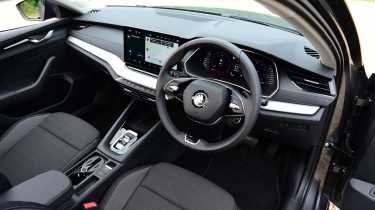
“If you need a hugely practical family car that’s comfortable, refined, good to drive and well-equipped, then the Octavia should be near the top of your shopping list.” - Alex Ingram, chief reviewer, who drove the Skoda Octavia in the UK.
While traditional hatchbacks and estate cars now find themselves lurking in the shadow of the SUV, there are still some excellent rivals that the Octavia has to face. Top options that can be bought in hatch or estate form include the Toyota Corolla, Vauxhall Astra and Kia Ceed. If you desire something even larger, there’s also the Skoda Superb to consider.
2. Skoda Elroq
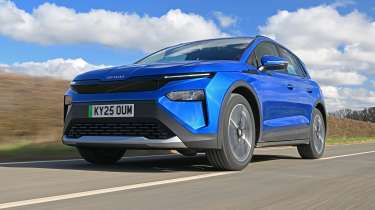
- Prices from £31,500
Pros |
Cons |
| Supremely comfortable | OK range for base model |
| Spacious, sophisticated and functional interior | No physical climate controls |
| Skoda’s ‘Simply Clever’ features | Average standard warranty |
The Skoda Elroq is only the brand’s second EV, but it’s also one of the best electric cars you can buy.
Although the Elroq is a bit smaller than its Skoda Enyaq cousin, it’s still a very roomy car with a 470-litre boot as well as a number of useful storage compartments. As always, there are a number of useful ‘Simply Clever’ features, too, including adjustable boot nets, umbrellas, a tyre tread depth gauge and an ice scraper.
In typical Skoda fashion, the Elroq is very drama-free in the way it drives. The fully-electric powertrain means it’s a quiet car for the most part, too, although the door mirrors do cause a fair amount of wind noise at motorway speeds. If you’re driving in the city, the Elroq’s 9.3-metre turning circle makes it a breeze to manoeuvre in narrower streets. The amount of power on offer depends on your chosen variant, but even the base Elroq 50 has more than enough shove for most needs.
While electric cars are now eligible for VED road tax charges, they still offer a considerable amount of savings on running costs compared to combustion-powered cars - especially if you can charge at home. If you’re a company car driver, you can also take advantage of a very low 2 per cent Benefit-in-Kind tax rate.
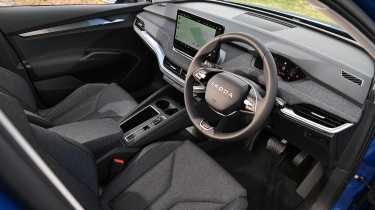
“The Elroq is so good that we see it creating a bit of a dilemma for Skoda: why would anybody need the larger Enyaq now?” - Ellis Hyde, news reporter, who drove the Elroq in the UK.
The electric SUV market is continuing to grow, and there are a number of similarly-priced alternatives to the Elroq. The Renault Scenic, Kia EV3 and Hyundai Kona Electric are all worthy of consideration. You also find even more options in our list of the best electric SUVs to buy.
3. Dacia Jogger
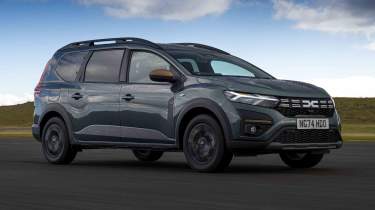
- Prices from £18,970
- Best value for money
Pros |
Cons |
| Affordable even in the highest specifications | Disappointing one-star Euro NCAP safety rating |
| Plenty of space for passengers and luggage | Hybrid model has an inconsistent brake pedal |
| Strong residual values for the class | Limited towing capacity for the hybrid version |
Check out the price of the Dacia Jogger and you may think it lacks quality and equipment, but this is simply not true.
Sure, it’s not as plush as some of the other models in this list, but the Jogger offers van-like capacity for supermini-like money. It’s easily one of the cheapest seven seaters you can buy brand-new today. You can also fold those seats for up to 2,085 litres of cargo space, so it’s an excellent load hauler as well. If you do want to use all seven seats, we recommend reserving the rearmost row for your smallest passengers, as it’s a little tight on leg and headroom.
The Jogger isn’t exactly sporty in its appearance, and it certainly isn’t like this to drive, either. Both the petrol and hybrid models take over 10 seconds to accelerate from 0 to 62mph but, realistically speaking, this probably won’t matter when you’re on the school run. If you’re planning on taking longer trips, we were particularly impressed with how quiet the hybrid car’s engine remains at higher speeds.
The hybrid-powered Jogger also has the edge when it comes to fuel economy, as it’ll achieve up to 58.9mpg on the WLTP combined cycle. The 0.9 TCe petrol engine isn’t alarmingly thirsty, though, as it’ll reach up to 48.7mpg on the official tests. A starting price of less than £19,000 (for the petrol model) is arguably the biggest highlight of them all.
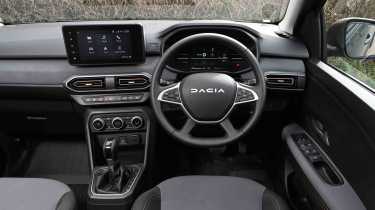
“There’s more to the Dacia Jogger than just passenger carrying, because it’s a practical car that offers versatility and low running costs” - Dean Gibson, senior road test editor, who drove the Jogger in the UK
The Dacia Jogger is quite a unique car as it combines people carrier, estate car and SUV design cues. For outright practicality, though, it's van-based MPVs that manage to come the closest at this price-point. The Citroen Berlingo, Vauxhall Combo Life, Peugeot Rifter and Ford Tourneo Connect are all hugely spacious inside and, unlike the Jogger, most of these cars have the option of fully-electric power.
4. Skoda Superb
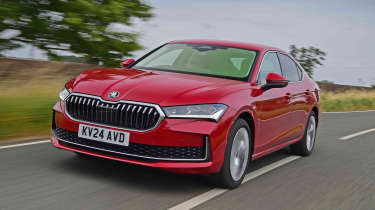
- Prices from £35,695
Pros |
Cons |
| Cavernous interior and boot | Not exciting to drive |
| Classy design | Only the estate gets plug-in hybrid |
| Smart technology | Not as cheap as it used to be |
Few cars are as boldly named as the Skoda Superb, but this is indeed one our favourite family cars for a variety of reasons.
Whether you choose the Superb in hatch or estate form, they both have generous boots with up to 690 litres on offer when all five seats are in place. The Superb’s cabin also feels well put together with some excellent materials; it withstood our expert road testers’ prodding and poking, so we reckon it’ll stand up well enough to the tests posed by your youngest passengers as well.
Much like the slightly smaller Octavia, the Superb comes with the option of mild-hybrid or diesel power, and both variants can return over 50mpg. The Superb didn’t exactly surprise us with its sporty driving experience on the move, but it is as calm and refined as we’d expect from a much pricier executive car. If you do want to firm things up a little bit, Skoda’s optional ‘Dynamic Chassis Control Plus' pack introduces adaptive dampers, but this will set you back by over £1,200.
While it’s true the Superb is more expensive than ever before, it’s still a car that feels like true value for money. In entry-level SE Technology spec — which starts from around £35,000 — you’ll still get an upmarket cabin that’s adorned with useful tech including a 13-inch touchscreen infotainment system along with Skoda’s clever 'Smart Dials'.
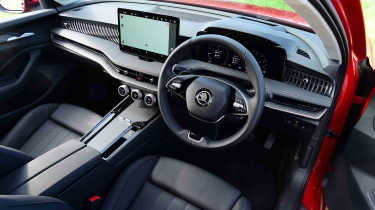
“The Skoda Superb combines everything we loved about its award-winning predecessor with newfound sophistication.” - Ellis Hyde, news reporter, who drove the Skoda Superb in the UK.
Regardless of its price tag, the Skoda Superb is aimed at the executive car market, so you’ll need to be prepared to fork out more cash if you want many of its competitors. The Mercedes C-Class and BMW 3 Series are two of the more obvious exec rivals, but the more mainstream Peugeot 508 and Volkswagen Passat are also worth a look.
5. Hyundai Tucson
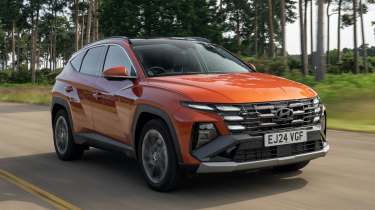
- Prices from £32,400
- Auto Express Mid-size SUV of the Year
Pros |
Cons |
| Hybrid power | Expensive plug-in hybrid model |
| Great on-board tech | Engine thrashy at higher revs |
| Premium feel | Not especially fun to drive |
The latest Hyundai Tucson has won our Mid-size SUV of the Year award four times on the trot, so it’s safe to say that we like it.
The Tuscon is a brilliant family SUV. Alongside the sturdy build quality and lots of safety kit that can be found in all models, there’s plenty of room for five people as well as a 620-litre boot. Hyundai has also adorned the cabin with a number of useful storage cubbies. If that still isn’t enough carrying capacity, the Tucson has a maximum braked towing weight of up to 1,510kg, depending on powertrain.
It certainly looks far sportier than its predecessors, and the latest Tucson does pack a reasonable amount of punch with power outputs ranging from 158bhp to 249bhp. The hybrid models are the most refined for the most part, but we did find the petrol engine to be rather noisy when pushed hard. It’s quite a big car, but the Tucson does have notably light steering, so this makes tighter streets and parking far less of a chore.
Petrol, hybrid and plug-in hybrid power are all up for grabs here, and it’s the latter that’s the most efficient on paper. We managed to eke over 30 miles of range from the 13.8kWh battery, although this was a lower figure than the official 38 miles. It’s here where the PHEV falls a bit short of the competition, as the Volkswagen Tiguan eHybrid claims over 70 miles on a single charge.
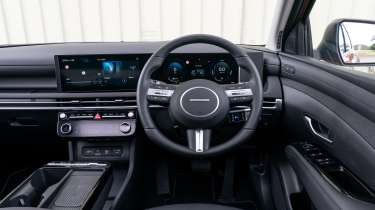
“The Hyundai Tucson strikes a good balance between being easy to drive and manoeuvre in town, stable and grippy enough on a country road and composed on the motorway.” - Ellis Hyde, news reporter, who drove the Tucson in the UK.
The Tucson has a very closely-related rival to contend with, the Kia Sportage, and the Sportage does have a slightly lower starting price when buying brand-new. Elsewhere, the Nissan Qashqai and Ford Kuga are also highly popular with buyers. You could also consider a fully-electric alternative such as the Renault Scenic, Skoda Enyaq or Tesla Model Y.
6. Kia EV3
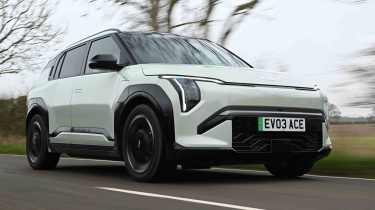
- Prices from £33,005
Pros |
Cons |
| A big battery means huge range | Not fun to drive |
| Large, practical boot | Rear-seat comfort |
| Comfortable ride at all speeds | Heat pump on top model only |
The Kia EV3 is one of the brand’s cheapest EVs to date, and it happens to be one of its best, too.
With a design that’s largely inspired by its EV9 big brother, the Kia EV3 is a very distinctive machine to behold, but it also ticks many of the fundamental family car boxes. It’s reasonably spacious for its size, with a decent amount of headroom on offer. The rear seats are best reserved for smaller passengers, though, as the passenger space is slightly sacrificed in favour of boot space (460 litres in total). If you are seating particularly young passengers in the back, the doors open wide so fitting a child seat and hooking it up to the ISOFIX points is a refreshingly straightforward task.
Being an electric car, the EV3’s acceleration is instantaneous which is particularly great for pulling away quickly from tricky junctions. Every EV3 has 201bhp on tap, but it’s better described as potent rather than entertaining. We’re big fans of Kia’s iPedal regenerative braking system, as it is highly adjustable and provides one-pedal driving should you want to use it.
If you have a wallbox charger on your driveway, a full charge should cost around £20, and this is far cheaper than an equivalent fill-up of petrol or diesel. Unfortunately, public chargers can push these costs to some alarming highs, so this particular benefit may be lost if you don’t have access to home charging. Opt for the larger 81.4kWh and the EV3 claims up to 347 miles on the WLTP combined cycle.
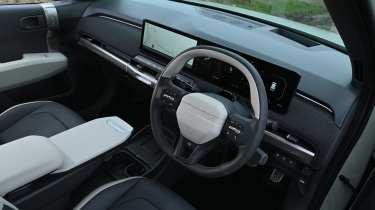
“In terms of price and size, the EV3 looks similar to Kia’s Niro EV, but most buyers will find the EV3 the more attractive option in most areas.” - Alex Ingram, chief reviewer, who drove the EV3 in the UK.
Compact electric SUVs are arriving in droves, so you’ll be spoiled for choice if you have your eye on this area of the market. The Hyundai Kona Electric, Volvo EX30 and even Kia’s own Niro EV continue to offer plenty of appeal, while newer models such as the Ford Puma Gen-E and Jeep Avenger are only piling on the pressure.
7. Honda Civic
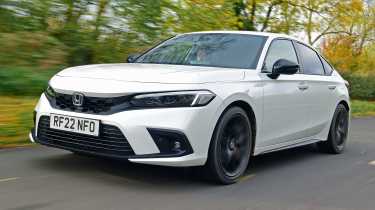
- Prices from £35,780
Pros |
Cons |
| Efficient hybrid powertrain | Firm low-speed ride |
| Good to drive | Road noise |
| Improved interior quality | Infotainment system a little dated |
The 11th generation Honda Civic - yes, it really has been around for that long - is a great family hatchback, but it doesn't come cheap.
Much like the many Civics that came before it, this model continues to feel like quite a grown-up hatchback that forgoes the gimmicks in favour of functionality (if you want theatrics then we’ll steer you towards the ferocious Type R). As with many cars, the Civic has grown in size over the years, but the advantage of its larger footprint is that there’s more legroom on offer than in the Kia Ceed or Toyota Corolla. Front passengers have a bit more overall space than those in the back, but nobody should feel too cramped. There’s 410 litres of boot space for the luggage, too.
This sensible theme continues behind the wheel. Although the hybrid powertrain is engineered to focus on efficiency, there’s still a healthy 181bhp on tap so it doesn’t feel sluggish at all. There’s almost a sporty feel to the Civic’s suspension, but it falls short of being firm. Instead, it feels very stable at higher speeds, with the impact of most road imperfections being numbed significantly. The small downside is a slightly fidgety ride at lower speeds.
The aforementioned focus on efficiency pays off, too, as the 2.0-litre hybrid powertrain claims 56.5mpg on the WLTP combined cycle. We managed closer to 50mpg during testing which isn’t too far off, but the Toyota Corolla performed slightly better during the same test at 54.2mpg.

“The Civic’s sloping roofline means it won’t quite match the versatility of some of the boxier, more upright SUVs out there, but it’s practical enough for most needs.” - Ellis Hyde, news reporter, who drove the Civic in the UK.
The Honda Civic has been a firm hatchback favourite in the UK for decades, but it's not the only long-standing choice in this market. The Volkswagen Golf and Vauxhall Astra are also household names, while the Toyota Corolla is slightly more efficient.
8. Hyundai Kona
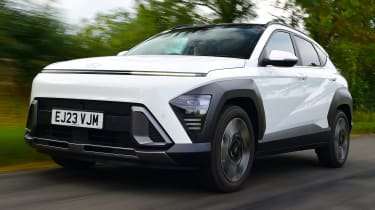
- Prices from £26,465
Pros |
Cons |
| Comfortable and refined | Not especially fun to drive |
| Spacious cabin | Hybrid and 1.0-litre versions are slow |
| Choice of petrol, hybrid and EV power | Too futuristic-looking for some |
Its predecessor was a decent car, but the latest Hyundai Kona boasts plenty of carefully thought-out improvements.
For starters, the second-generation model is a much more distinctive machine than the first, but this doesn’t come at the expense of its ability to work for families. The newer car has a longer wheelbase, and the result is a big increase in passenger and cargo space. If anything, the Kona’s appearance is quite deceiving as our testers had almost as much room to spread out as they did in the larger Hyundai Tucson. The boot stands at 466 litres with the rear seats in place, and this is even more than the Skoda Kamiq.
It’s not just space where the Kona feels like a much bigger car, we also found it to be a superbly comfortable and quiet place to cover plenty of miles. All but the 1.0-litre petrol model provide an adequate amount of shove for day-to-day driving, To bring it a bit closer in line with the brand’s fully-electric Ioniq range, there’s plenty of tech to be found, too, including Hyundai’s excellent 12.3-inch infotainment touchscreen which looks pretty good and is easy to use.
You can select from petrol or hybrid power options, but we’d look to the Kona Electric with its pure EV powertrain as the best of the bunch for both performance and running costs, it also provides a range of up to 319 miles from a full charge.
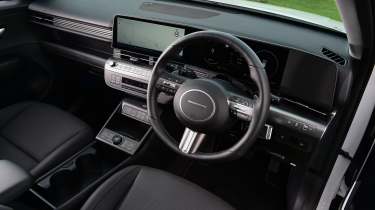
“The Hyundai Kona is a fantastic example of how a brand can listen to feedback and act upon it.” - Ellis Hyde, who drove the Kona in the UK.
With multiple fuel types to choose from, the Hyundai Kona faces an equally diverse range of competitors. The petrol and hybrid cars are competing with the likes of the Renault Captur, Dacia Duster, Toyota Yaris Cross and Peugeot 2008. The Kona Electric model, meanwhile, goes up against models such as the Vauxhall Mokka Electric, Smart #1 and Kia EV3.
9. BMW i4
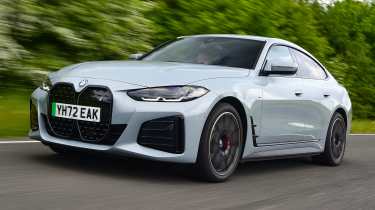
- Prices from £51,280
- Best to drive
Pros |
Cons |
| Exceptional build quality | Pricier than some key rivals |
| Sharp handling, precise steering, and excellent grip | Less rear legroom compared to some competitors |
| Advanced infotainment and driver assistance features | Four-star Euro NCAP safety rating when rivals have five |
The combustion-powered 3 Series is a great car, but the electric BMW i4 is the one that makes our family car top 10.
Unlike some EVs which trace their roots back to a combustion-powered car, the BMW i4 makes no compromises when it comes down to practicality. The boot will hold up to 470-litres of luggage and there’s a good amount of room for passengers, although the front occupants will have the most space. The hatchback-style tailgate also makes loading far easier than the traditional letterbox-style boots on rivals such as the Tesla Model 3 and Hyundai Ioniq 6.
BMW’s slogan is the ‘ultimate driving machine’, and while that’s up for debate the i4 is indeed an enjoyable car to drive. Despite its heft kerb weight of over two tonnes, this EV does an excellent job of maintaining its composure through corners. The steering offers a pleasing amount of feedback, too, and even the least powerful eDrive35 variant pumps out 282bhp.
As with any other EV, the BMW i4 offers some serious potential savings when it comes to fuelling and taxing it. However, this is a premium car so you will be paying for the privilege. As well as a higher purchase price, insurance quotes will be a bit on the higher side.
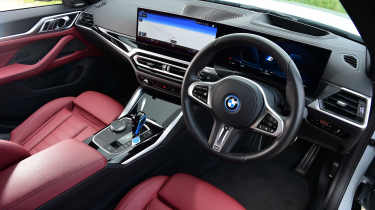
“It’s not just keen drivers who will be impressed with the i4, because it oozes quality and is packed with the latest on-board technology.” - Ellis Hyde, news reporter, who drove the i4 in the UK.
The electric executive car market is a fiercely competitive one. Tthe BMW i4 faces some long-standing foes such as the Tesla Model 3 and Polestar 2, as well as some equally capable newcomers including the BYD Seal and Hyundai Ioniq 6.
10. Citroen C4
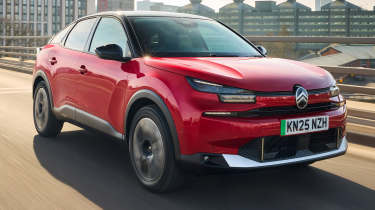
- Prices from £22,585
Pros |
Cons |
| Keen pricing | No manual option |
| Mix of powertrains | Smaller boot than rivals |
| Comfortable ride | Clunky interior technology |
A mid-life refresh has brought the Citroen C4 back into the limelight, and while it still isn’t the most groundbreaking family hatch, it is a very affordable one.
While the updated C4 looks a bit different on the outside, it’s on the inside where you’ll find its most impressive attribute - a refreshingly simple cabin with plenty of storage solutions. Moving up the trim levels introduces more useful kit, too, such as a dash-mounted tablet stand or variable height boot floor. No matter which C4 you go for, you’ll have 380 litres of boot space to use, which is just one litre short of a Volkswagen Golf.
Luxurious comfort for supermini money has long been a Citroen party trick, and the C4 continues this trend with ‘hydraulic cushions’ in the suspension that do an excellent job of ironing out bumps in the road. One area where sportiness does get in the way, though, is with visibility, as the C4’s spoiler obscures the view out of the rear windscreen.
C4 buyers have the choice of petrol and hybrid power, as well as the fully-electric Citroen e-C4. As you’d probably expect, the e-C4 is the one to go for if you want the biggest savings on running costs, but it does carry a premium of around £5,000 over the regular C4.
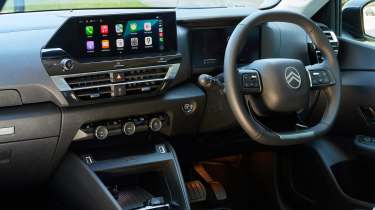
“Citroen’s family hatch is now treading a value-driven path few other manufacturers can seemingly compete with.” - Alastair Crooks, senior news reporter, who drove the C4 in France
There are a number of hatchbacks that also come with the choice of combustion or fully-electric power, in fact two of them, the Peugeot 308 and Vauxhall Astra are related to the Citroen C4. On top of these cars, a very well-established hatchback also has the C4 in its sights, and that car is the Volkswagen Golf.
How to choose the best family car
Choosing a family car is a very important decision. Here are some key questions to ask when building your shortlist…
What type of family car do I want?
As you can see, ‘family car’ is quite a broad term. There are numerous cars of varying shapes and sizes that all offer spacious cabins, cavernous boots, easy access, ISOFIX points and loads of safety equipment, but some might not necessarily work for you.
The very first thing you need to decide is how many seats and how much cargo space you need. Once you’ve determined how much space you need for your loved ones and their luggage, you’ll then start to paint a picture of which cars will and won’t work for you.
A smaller family with one or two children might be perfectly well served by a traditional hatchback such as the Citroen C4, but a larger family will probably require something larger like the seven-seater Dacia Jogger.
Once you’ve decided on your required space levels, you’ll then need to decide which type of car will best meet your needs and appeal to your personal tastes:
Hatchbacks
- Pros: easy to drive, generally affordable to buy, sensible running costs
- Cons: limited space, no seven-seat options
Hatchbacks are some of the more compact offerings on the family car market, so they’re among the easiest to drive and park. However, their smaller stature means you’ll only have a limited amount of boot and passenger space on offer. Families who need more than five seats will also have to look elsewhere.
Estate cars
- Pros: huge boots, usually good to drive
- Cons: prices can be quite high, no more than five seats
Estate cars offer a huge amount of boot space but without the van-like appearance of a traditional MPV. While they successfully tread a careful balance between form and function, there still aren’t any seven-seaters to choose from on the current market. If you only need five seats, though, these cars are often enjoyable to drive as well as spacious.
SUVs
- Pros: loads to choose from, some seven-seater options
- Cons: some models are costly to run, not always the most practical option
Take just a single journey on the UK’s roads and you’ll see just how popular SUVs have become with buyers. The combination of attractive styling, spacious interiors and a high driving position are really striking a chord with buyers, particularly those with families. There are a number of different sizes of SUV on offer, so it’s important to carefully examine any potential purchase, as some are much bigger, safer and well-equipped than others.
MPVs
- Pros: acres of space, easy access
- Cons: very boxy to look at, declining popularity
MPVs (also known as people carriers) are the more traditional route to a car with seven seats, although some models do only come with five. Due to their boxy appearance, they’ve fallen out of favour compared to the fashionable SUV, but few cars come remotely close to MPVs when it comes to outright interior space. Those with the biggest families can find several van-based models on today’s market at very reasonable prices.
How do I know that a family car is safe?
Every mainstream car on sale in the UK is rigorously tested by an independent body called Euro NCAP. Testing is carried out to determine how safe a car is in the event of a crash, and how well its occupants are protected.
As well as a star rating out of five for general safety, Euro NCAP’s scores also include individual percentages for adult and child occupant safety, as well as the protection of vulnerable road users (such as pedestrians) and the performance of any on-board safety technology. The safest cars on sale are those with the highest scores, so aim for the models with a five-star rating.
Should I buy an electric family car?
There are an increasing number of electric family cars entering the market, and we recommend a number of them right here on this list. Thanks to rapid developments in technology and infrastructure, some people, particularly those with access to home charging, are in a great position to comfortably live with an EV and reap the benefits. EVs are ideal for short trips like school runs and shopping although family holidays can be more of a challenge if you have to charge on route.
However, if you don’t feel like a fully-electric car will suit your personal circumstances but still want to reduce your emissions and running costs, there are plenty of great hybrid family cars to choose from, too.
Did you know you can sell your car through Auto Express? We’ll help you get a great price and find a great deal on a new car, too.

